How loud is your environment? Understanding this is crucial, and a decibel meter is the key.
These tools measure sound levels in decibels (dB), essential for protecting hearing in noisy settings, complying with noise regulations, and assessing sound quality in different environments.
We’ve rigorously tested various decibel meters to find the best in terms of precision, user-friendliness, and functionality.
Our firsthand experience has led us to a selection that caters to professionals and hobbyists alike, ensuring you get accurate readings wherever sound level is a concern.
Here are NerdTechy’s top picks:
- Extech 407730 – Provides a good balance of accuracy with built-in safety standards. It’s still a little cheaper than top end models, but offers only 2 dB of error, with measurements consistent across the entire range. Available with a calibration certificate as well as a material traceability document, so it’s still suitable for professional environments.
- Protmex PT02 – Simple in design, extremely affordable, and easy to read. For music and recording purposes, it’s perfect. Since you don’t have to follow safety regulations, it’s minor inaccuracies aren’t such a big deal. And in exchange, you save a ton of money on the purchase price.
- REED Instruments R8050 – Perfect for an industrial environment where occupational health and safety are important. This meter has a dual range sensor that has a consistent 1.5 dB of error – among the best we’ve tested. It meets ANSI and IEC type 2 standards, making it the number one choice for health and safety professionals.
- Need some help? Check our FAQs section for answers to some of the most commonly asked questions regarding decibel meters and their uses.
Extech 407730

As a prominent manufacturer in the automation and controls industry, Extech put their advanced technology to work in this affordable, but professional-grade sound level meter.
The Extech 407730 is available in two different options. The singe range model – our primary choice – can measure sound levels between 40 and 130 decibels.
The dual range model measures 35 to 130 decibels, split into two different levels for higher accuracy in quieter environments.
If you’re using this meter in a professional environment, they’re also available with calibration certificates, or with a NIST certificate of traceability.
Design & Durability
At only 2.2 inches wide and 1.7 inches thick, the Extech is extremely compact. It’s easy to hold, and can quickly be slipped into your tool belt until you need it.
At only 6 ounces in weight, it’s not something that you’re going to find frustrating to lug around.
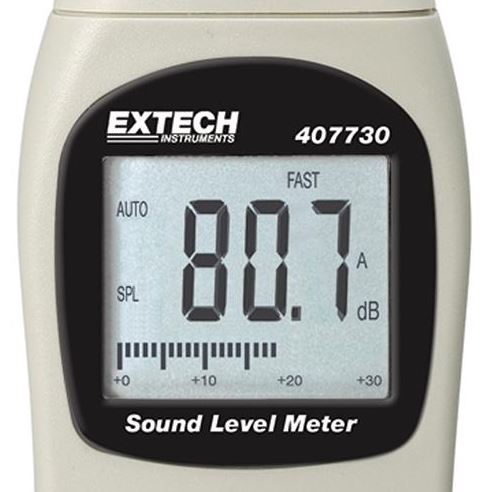
It’s got a large LCD display with high-contrast, easy to read text. The display provides both a bar-graph reading, as well as a numerical value showing the current sound level in decibels.
Six buttons along the front allow you to control the most important aspects of the meter’s functionality.
On the top you’ve got a power button, and RNG which allows you to change the measured range. Below, you’ve got A/C which allows you to choose frequency weighting.
This adjusts whether it’s focusing primarily on high frequencies or low frequencies, an important feature for omitting resonance.
F/S changes the speed and responsiveness of the meter. REC begins measurement, and MAX HOLD keeps the display indicating the highest SPL measured over the duration of your recording.
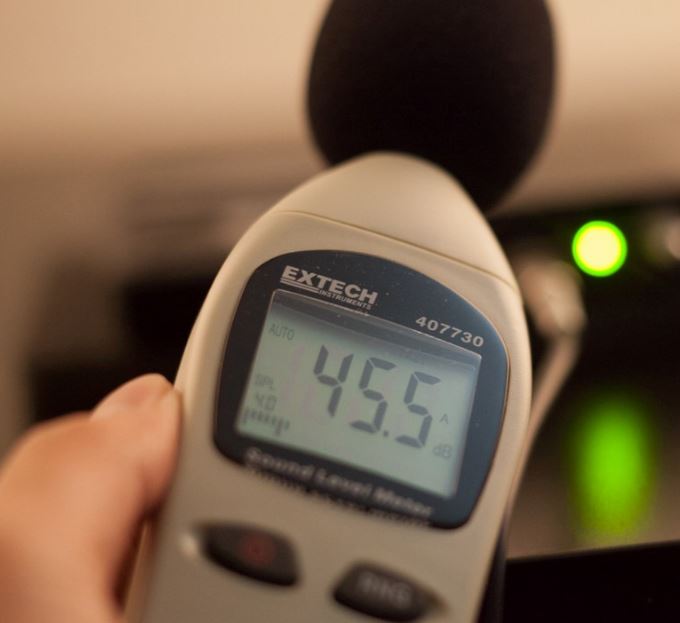
Between the thick plastic enclosure and the metal condenser microphone enclosure, this meter is built to a high standard.
It’s suitable for use in an industrial environment, and the one-year warranty ensures that you’re protected from any unexpected damage.
Measurement & Accuracy
This meter uses a half-inch condenser microphone enabling it to accurately measure sound levels across a wide range of frequencies. It’s got a resolution of 0.1 decibels, so even tiny changes in sound pressure levels are instantly viewable.
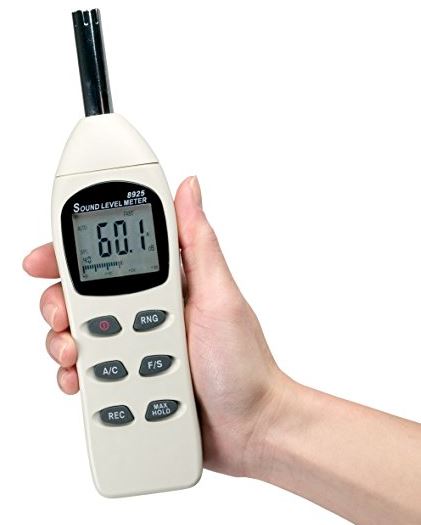
The meter is calibrated to have a maximum error range of 2 dB. For venue measurements, this is more than accurate enough to get a safe reading.
For safety applications, the calibration certificate is available enabling you to meet any legislative requirements needed for your documentation.
This hardware is extremely fast to update the display, with only a 40 millisecond delay between sound measurement and notification time.
Features
Although the functionality is quite simple, there are a few bonus features that made this meter stand out.
This kind of hardware is pretty power hungry, and requires four AAA batteries to run. But thanks to the auto-off feature, it will always conserve power when not in use.
This meter also makes it easy for you to track historical data. It can show you the change in sound levels over time, and also track frequency changes.
These features are important for use in an industrial setting, making this an idea choice for safety professionals.
REED Instruments R8050 Sound Level Meter
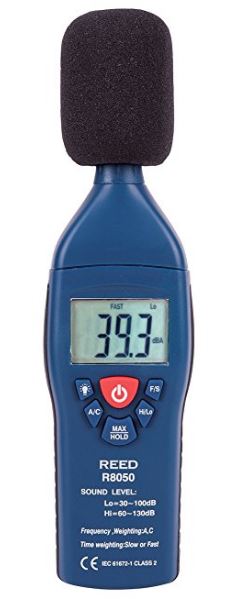
REEDs safety-first design is most evident in this high end sound level meter. Designed specifically for health and safety professionals, there are many features available that will make your job easier.
The REED Instruments R8050 has dual-range measurement, which allows them to get higher levels of accuracy out of a simple and affordable sensor. It is one of the most expensive options on the market, but it’s well-engineered design offers unparalleled functionality.
Design & Durability
The stylish blue enclosure of this decibel meter definitely stands out from the crowd. But for us, what really caught our attention was the simple, easy to use interface.
The power button is located front and center, making it easy to turn it on or off. Around the power button is a set of five buttons, each of which control one of the core features.
A/C and F/S control the speed and frequency measurement, while MAX HOLD allows you to isolate the highest measured variable. Hi/Lo lets you choose between the two frequency ranges easily.
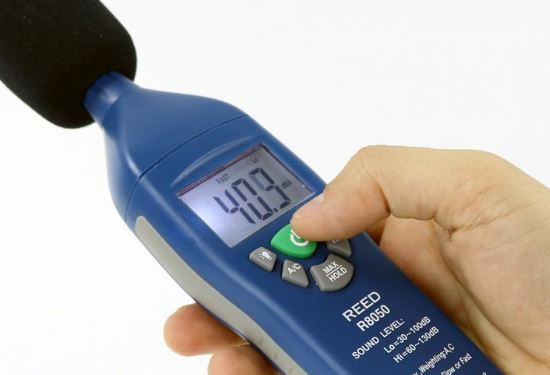
All of these buttons are useful, but in our eyes the most useful button is the backlight. This is one of the few SPL meters that provides an LED backlight, enabling you to read the display easily even in a dark environment.
To improve ease of use, the two frequency ranges are printed on the face of the meter. This lets you know when you need to change the range, so you’ll never be caught with unusable measurements.
From a durability standpoint, this meter is definitely above average. It’s made from two pieces of molded plastic, internally reinforced to prevent damage caused by drops or bumps.
While most users won’t require such a high level of durability, those of you in an industrial environment will appreciate the additional reinforcement.
Measurement & Accuracy
If your job requires that you use a meter that meets ANSI and IEC type 2 standards, this is the model you want.
The half-inch electret condenser microphone is built to a higher standard than the simple models found in cheaper options.
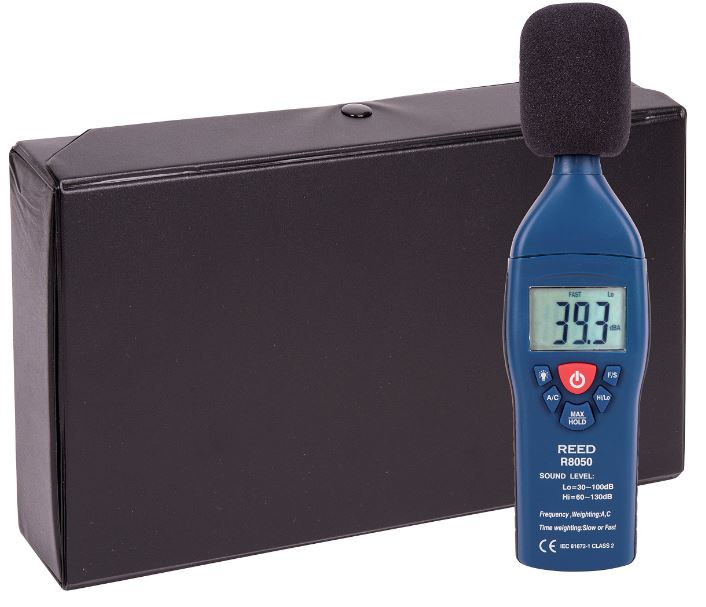
It’s accurate to + or – 1.4 decibels, measured across 35 to 100 decibels, or 65 to 135 decibels. Splitting the range like this is the main reason for the additional accuracy, and helps maintain stable measurements over a long period of time.
Even if you’re using this daily for many years, you’re not going to see the accuracy start to drift over time.
Features
If you’re trying to measure sound response in a performance & audio environment, you want a meter that provides fast, accurate measurements. But if you’re working in a health and safety environment, then it’s preferable to have something that has a slower response.
The REED Instruments R8050 is dual mode, so you can select between fast and slow response depending on what your requirements call for.
The meter also has a tripod mount built right in, so you can take accurate, verifiable measurements from a specific physical location.
When combined with the low battery alarms and over range alarms, you don’t have to spend a lot of time worrying about whether the meter is functioning correctly.
Protmex PT02
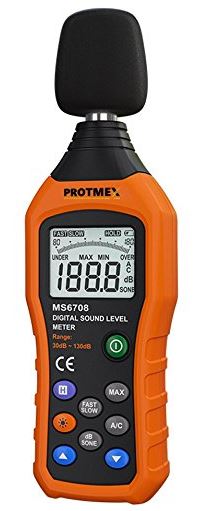
If you’re looking for an affordable way measure sound levels, the Protmex PT02 has you covered. This sound level meter is available for a fraction of the price of competing options, but doesn’t skimp on features.
Design & Durability
Featuring a plastic enclosure wrapped in rubber, this is one of the most ergonomic options on the market. It’s a little larger than some, which enabled them to use a larger display.
This makes it easy to check your sound levels with a quick glance, whether you’re looking at the handy bar graph or the numerical value.
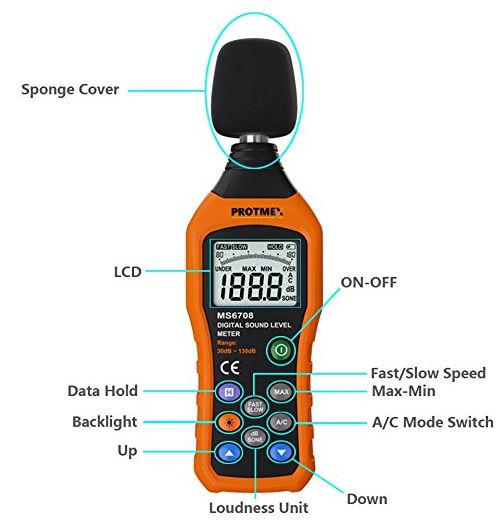
The injection molded plastic isn’t the strongest material on the market, but the rubber adds a ton of durability to it. We wouldn’t recommend it for industrial environments, but for music venues it’s more than strong enough.
Looking at the controls, it might appear like there are more features on this meter than on others. In reality, the controls are just a little more spread out. You select the option you want to change, then use the up and down arrows to make your selection.
Measurement & Accuracy
The compressor microphone found in the PT02 is capable of measuring sound levels along a single range. It can detect sounds as low as 30 decibels, or as high as 130 decibels.
Its accuracy varies depending on the frequency recorded. Low frequencies are up to 1.5 dB, while high frequencies are up to 5 dB above or below the indicated measurement.
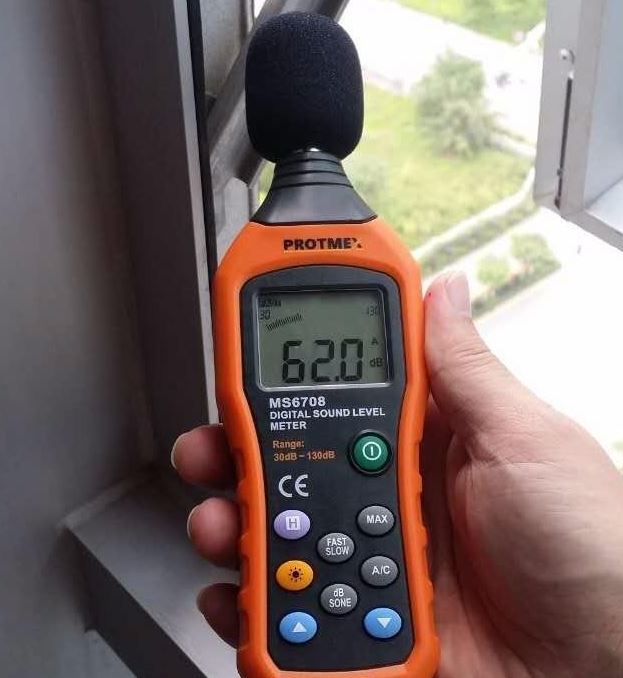
This meter takes two samples per second. In fast mode, the screen will automatically display the latest reading. In slow mode, there is a 1 second delay between screen updates.
What you see on your screen is actually an average of all individual measurements over the previous second, balancing out the peaks and valleys with most audio applications.
Features
What’s unique about this model is the fact that specific frequencies can be isolated and measured separately. You can get two measurements for both the high and the low frequencies, with a maximum difference of 50 decibels in between.
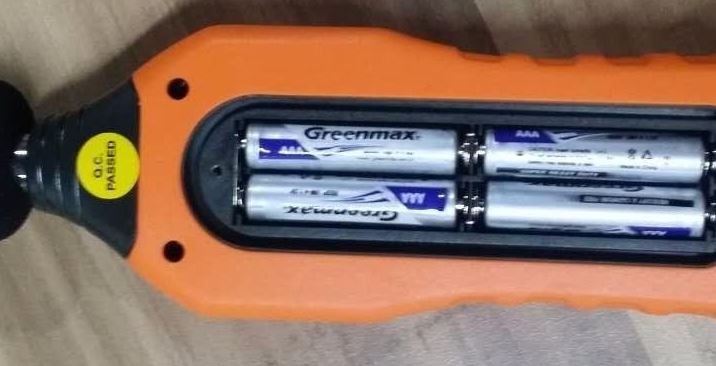
The meter also provides you with a handy bar graph you can use to compare and contrast different measurements. They refer to each section of the bar graph as a “gear.”
The range are 30 to 80 dB, 40 to 90 dB, 50 to 100 dB, 60 to 110 dB, 70 to 120 dB, and 80 to 130 dB. There is some overlap between gears, but this allows the graph to move smoothly, rather than jumping all over the place.
Best of all, it’s powered by 4 AAA batteries for easy replacement whenever that may be necessaery.
Decibel Meter FAQs
What is a decibel meter?
A decibel meter is a device that measures sound pressure levels, displaying them in decibels (dB). It’s used to assess noise levels in various environments, ensuring compliance with safety standards and aiding in acoustic analysis.
Why is measuring decibels important?
Measuring decibels is crucial for protecting hearing, maintaining a comfortable environment, and complying with noise regulations. High noise levels can cause hearing damage, making decibel meters essential in noisy workplaces and public areas.
Can decibel meters measure all sound frequencies?
While most decibel meters capture a wide range of frequencies, their sensitivity can vary. Some are better suited for low-frequency sounds, while others excel in high-frequency measurements. It’s important to choose a meter that aligns with your specific needs.
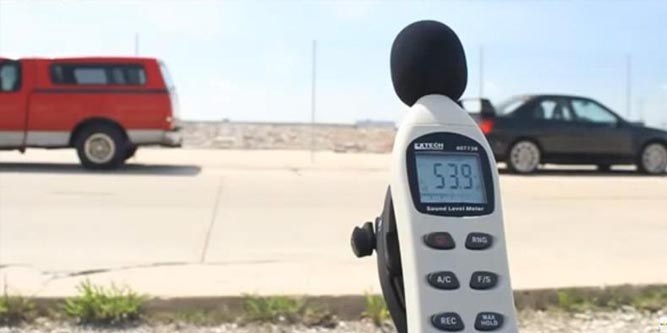
How accurate are decibel meters?
The accuracy of decibel meters depends on their quality and calibration. Professional-grade meters are typically more accurate, often required for legal or scientific purposes. For general use, standard meters provide reasonably accurate readings.
Do decibel meters need calibration?
Regular calibration is recommended to maintain accuracy, especially for professional-grade meters. Calibration ensures the device’s readings are consistent with true sound levels, which is crucial for reliable measurements.
Can I use a decibel meter outdoors?
Many decibel meters are suitable for outdoor use, but it’s important to consider factors like weather resistance and the ability to filter background noise for accurate outdoor measurements.
Meet Ry, “TechGuru,” a 36-year-old technology enthusiast with a deep passion for tech innovations. With extensive experience, he specializes in gaming hardware and software, and has expertise in gadgets, custom PCs, and audio.
Besides writing about tech and reviewing new products, he enjoys traveling, hiking, and photography. Committed to keeping up with the latest industry trends, he aims to guide readers in making informed tech decisions.

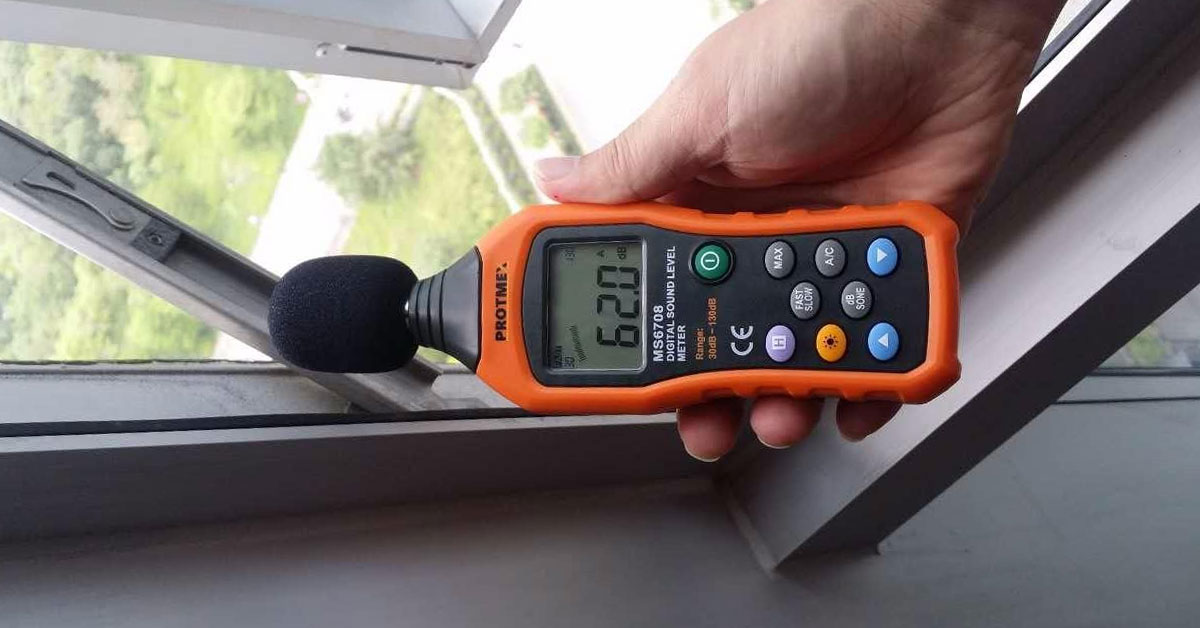
I saw some very inexpensive meters online. They cost much less than these. I just want to monitor some noise nuisances around my neighborhood. Also, want it to be reputable, in case I go to court.
I am looking for sound meter that will monitor and record loudness of snoring over a few nights and give me a print out.
Any suggestions?
Great read! Thanks for all the tips. I’m looking to measure the ambient sound in my bedroom for an upcoming soundproofing project I’ll be starting. I want a good before and after average to compare. Can you recommend a unit that has a 24 hour or some other long-term average that shows on the screen? The idea I have is to leave it set up for a day at a time, come in and record the value for about a week or so before the project and do the same after the project. Of course, I’ll have some peaks where I’m in the room making noise, but generally, that should level out over the course of a week. Thanks!
Hi
My child is running a high velocity fan during the night at full speed together with tranquility sleep music with deep base sounds,,,, is this harmful to their health and ears,,, sounds like thunder rumble all through the night,,,, please advise urgently,,, as I am very worried!!!
Thanks!
I’m looking for a sound meter to measure a loud hum that is in my apartment and load machinery on the roof of my apt that keeps me up at night
I am looking for a sound meter that has the foam on it so I can cover the microphone with different materials for a science project but is also very inexpensive